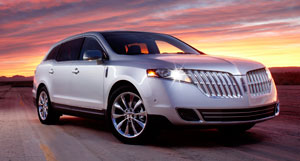
ANN ARBOR, MI – Generation X, often referred to as the “slacker generation,” has shed that stereotype and now is a coveted consumer group at the top of its earning potential, Ford Motor Co. officials say.
With pockets flush with cash, consumers born between 1965 and 1976 are the target of Ford’s Lincoln brand, which is trying to reinvent itself after years of giving ground in the profitable luxury segment.
“We have an aging owner body, and we have the ability to move it in the right direction and get younger,” Matt VanDyke-marketing communications director, tells Ward’s at a recent media event here.
“To think we could flip over and get young 20-somethings into a luxury product at this point and consider Lincoln is something that I think is too much of a stretch,” he says.
Lincoln brass spent considerable time determining the unique makeup of Gen Xers, which VanDyke defines as being in their mid-30s to mid-40s. Unlike traditional luxury buyers, these consumers don’t want to appear “ostentatious.” Rather, they are “folks that are time-starved and look at luxury as something that makes their life simple and easier.”
VanDyke says Generation X represents a “white space” in the automotive market, meaning there are no other auto makers targeting them. Alexander Edwards, president of Strategic Vision Inc., a California-based automotive consultancy, agrees.
“They’re a target that there’s not a battlefield of people going after,” Edwards tells Ward’s. “You have a group of folks earning a bit more than people a little older and younger than they are.

“(Lincoln) can have results today, rather than when Generation Y (ages 15-32) grows up.”
The reason Gen Y most often is viewed as a better target is its sheer size, especially when compared with the much smaller Gen X group. The U.S. Census Bureau says Generation Y numbers 73.5 million, while Generation X totals 49.1 million. The largest generation in recent times, the Baby Boomers, comprises 76.6 million.
Edwards says Gen X’s lower number won’t hamper Lincoln’s efforts. In fact, it may help.
“Many of the Boomers feel they’re the age of Gen Xers,” he says. “When you have a vehicle that doesn’t’ remind you how old you (are), you can have a positive, youthful, luxurious image. So (Lincoln) also will get Boomers, too.
“And it will have an impact on Gen Y, because they’ll see what successful people are driving today.”
VanDyke concurs with Alexander, noting past advertising campaigns targeting a specific group often attracted consumers from outside the demographic.
To reach Gen X, Lincoln’s marketing focuses on the combination of luxury and technology. The campaign’s TV spots employ music the group finds nostalgic, the auto maker says.
For instance, an ad featuring the Lincoln MKS flagship sedan features a remake of David Bowie’s “Space Oddity,” while an upcoming segment for the Lincoln MKT cross/utility uses a version of the 1980s classic “Under the Milky Way," by Australian alternative rock band The Church.
“Gen X has a connection to the music we use,” says Thomas Zaremba, marketing communications manager. “So we find music that is relevant to them and re-cut it in a modern, unique way that captures their attention. And that’s about all they need to explore our product and see why it’s right for them.”
Zaremba admits the music is narrowly focused on Gen X and unlikely to attract older, traditional buyers. But she is adamant in saying Lincoln does not want to alienate its diehard loyalists, noting there are other multi-media campaigns intended for them. “So we do continue to talk to them, just not necessarily in our TV efforts.”
In developing the new lineup of Lincolns, which now includes the MKS and MKZ sedans, MKX and MKT CUVs and Navigator fullsize SUV, engineers, designers and product planners specifically benchmarked Audi and Lexus brands, the former for its handling attributes and the latter for its quiet interiors.
VanDyke stops short of saying Lincoln has to play catch-up in the luxury segment, but he admits “it’s no secret we have progress to make.”
Through September, Lincoln sold 59,236 units, according to Ward’s data. That compares with Lexus’ 149,408, Cadillac’s 73,024 and Audi’s 59,518.
While it appears Lincoln may be late in rejoining the luxury game, VanDyke says until now the marque lacked the product to take the next step.
“If two years ago we started talking about Lincoln in a different way and the product evidence and proof wasn’t where it is today, we would have failed,” he says.
“But now we have the proof points and the new products, and it gives us the opportunity to really work on the brand. To not do it in tandem would have been too tough of a hill to climb.”




